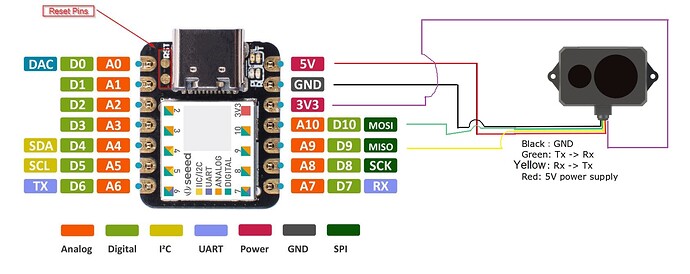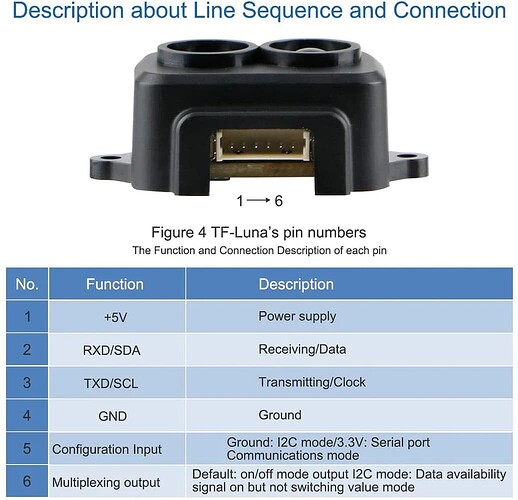Hi, I am a relatively new Arduino programmer.
I am trying to hook up a TF-Luna sensor to a Seeeduino XIAO.
I am using UART from the TF-Luna.
Here is my schematic:
Here is the code I am trying to run:
/* File Name: TFMP_example.ino
* Developer: Bud Ryerson
* Inception: 29JAN2019
* Last work: 10SEP2021
* Description: Arduino sketch to test the Benewake TFMini Plus
* time-of-flight Lidar ranging sensor using the TFMPlus Library.
* Default settings for the TFMini Plus are a 9600 serial baud rate
* and a 100Hz measurement frame rate. The device will begin returning
* measurement data right away:
* Distance in centimeters,
* Signal strength in arbitrary units,
* and an encoded number for Temperature in degrees centigrade.
* Use the 'sendCommand()' to send commands and return a status code.
* Commands are selected from the library's list of defined commands.
* Parameters can be entered directly (9600, 250, etc) but for
* safety, they should be chosen from the library's defined lists.
*/
#include <TFMPlus.h> // Include TFMini Plus Library v1.5.0
TFMPlus tfmP; // Create a TFMini Plus object
#include "printf.h" // Modified to support Intel based Arduino
// devices such as the Galileo. Download from:
// https://github.com/spaniakos/AES/blob/master/printf.h
// The Software Serial library is an alternative for devices that
// have only one hardware serial port. Delete the comment slashes
// on lines 37 and 38 to invoke the library, and be sure to choose
// the correct RX and TX pins: pins 10 and 11 in this example. Then
// in the 'setup' section, change the name of the hardware 'Serial2'
// port to match the name of your software serial port, such as:
// 'mySerial.begin(9600); etc.
#include <SoftwareSerial.h>
SoftwareSerial mySerial( 9, 10);
void setup()
{
Serial.begin( 9600); // Intialize terminal serial port
delay(20); // Give port time to initalize
printf_begin(); // Initialize printf.
printf("\r\nTFMPlus Library Example - 10SEP2021\r\n"); // say 'hello'
mySerial.begin( 9600); // Initialize TFMPLus device serial port.
delay(20); // Give port time to initalize
tfmP.begin( &mySerial); // Initialize device library object and...
// pass device serial port to the object.
// Send some example commands to the TFMini-Plus
// - - Perform a system reset - - - - - - - - - - -
printf( "Soft reset: ");
if( tfmP.sendCommand( SOFT_RESET, 0))
{
printf( "passed.\r\n");
}
else tfmP.printReply();
delay(500); // added to allow the System Rest enough time to complete
// - - Display the firmware version - - - - - - - - -
printf( "Firmware version: ");
if( tfmP.sendCommand( GET_FIRMWARE_VERSION, 0))
{
printf( "%1u.", tfmP.version[ 0]); // print three single numbers
printf( "%1u.", tfmP.version[ 1]); // each separated by a dot
printf( "%1u\r\n", tfmP.version[ 2]);
}
else tfmP.printReply();
// - - Set the data frame-rate to 20Hz - - - - - - - -
printf( "Data-Frame rate: ");
if( tfmP.sendCommand( SET_FRAME_RATE, FRAME_20))
{
printf( "%2uHz.\r\n", FRAME_20);
}
else tfmP.printReply();
// - - - - - - - - - - - - - - - - - - - - - - - -
/* // - - - - - - - - - - - - - - - - - - - - - - - -
// The next two commands may be used to switch the device
// into I2C mode. This sketch will no longer receive UART
// (serial) data. The 'TFMPI2C_example' sketch in the
// TFMPI2C Library can be used to switch the device back
// to UART mode.
// Don't forget to switch the cables, too.
// - - - - - - - - - - - - - - - - - - - - - - - -
printf( "Set I2C Mode: ");
if( tfmP.sendCommand( SET_I2C_MODE, 0))
{
printf( "mode set.\r\n");
}
else tfmP.printReply();
printf( "Save settings: ");
if( tfmP.sendCommand( SAVE_SETTINGS, 0))
{
printf( "saved.\r\n");
}
else tfmP.printReply();
// - - - - - - - - - - - - - - - - - - - - - - - -
*/
delay(500); // And wait for half a second.
}
// Initialize variables
int16_t tfDist = 0; // Distance to object in centimeters
int16_t tfFlux = 0; // Strength or quality of return signal
int16_t tfTemp = 0; // Internal temperature of Lidar sensor chip
// Use the 'getData' function to pass back device data.
void loop()
{
delay(50); // Loop delay to match the 20Hz data frame rate
if( tfmP.getData( tfDist, tfFlux, tfTemp)) // Get data from the device.
{
printf( "Dist:%04icm ", tfDist); // display distance,
printf( "Flux:%05i ", tfFlux); // display signal strength/quality,
printf( "Temp:%2i%s", tfTemp, "C"); // display temperature,
printf( "\r\n"); // end-of-line.
}
else // If the command fails...
{
tfmP.printFrame(); // display the error and HEX dataa
}
}
I have installed the TFMini Plus library from Bud Reyerson.
When I run it, this is the output I get:
21:09:05.638 → Status: HEADER
21:09:05.638 → Data: E8 E8 EC E8 E8 EC EC E8 EC
21:09:06.673 → Status: HEADER
21:09:06.673 → Data: E8 EC E8 E8 EC E8 EC EC E8
21:09:07.740 → Status: HEADER
21:09:07.740 → Data: E8 EC E8 E8 EC EC EC E8 E8
21:09:08.811 → Status: HEADER
21:09:08.811 → Data: EC EC E8 EC EC EC E8 E8 EC
I see that the Seeeduino has RX and TX on pins 6 and 7. Should I be using those instead of Software Serial? How would I do that?
Any ideas?

